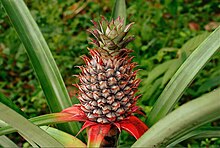Pineapple
The pineapple is a fruit. It is native to South America, Central America and the Caribbean. The word "pineapple" came from European explorers, who thought the fruit looked similar to a pine cone.[2] The pineapple is a tropical plant and it must not be kept under 10 degrees. It takes a long time for the pineapple to grow. It mainly depends on the location and the growing conditions it gets. If the temperature is warm, the pineapple will grow faster. On average, it takes about two to three years to grow.[3] If the fruit travels by boat, the fruit must be picked before ripening, since the trip takes a long time. Sometimes, pineapple has to travel by boat to be accessible to all. It is different for air travel. The pineapple can be picked when it is grown, since travel time is short. In most countries, pineapples are called ananas.
| Pineapple | |
|---|---|

| |
| A pineapple on its parent plant | |
| Scientific classification | |
| Kingdom: | Plantae |
| Clade: | Tracheophytes |
| Clade: | Angiosperms |
| Clade: | Monocots |
| Clade: | Commelinids |
| Order: | Poales |
| Family: | Bromeliaceae |
| Genus: | Ananas |
| Species: | A. comosus
|
| Binomial name | |
| Ananas comosus (L.) Merr.
| |
| Synonyms[1] | |
|
List
| |
Nutrition
changeA pineapple contains fiber and vitamin C. The stem of the pineapple has an enzyme having healing effects, anti-inflammatory effects and it may reduce edema. The enzyme from the pineapple is beneficial for a person who wants to go on a good diet. Pineapple contains a lot of manganese; the body needs manganese to build strong bones.[4][5]
Varieties
changeIn the world, there are a lot of varieties of pineapples. In fact, there are more than one hundred varieties that grow in different sizes. Four of those are the main varieties:
- Sugarloaf pineapple: It usually grows in Mexico and Venezuela. The flesh is white and there is no woodiness.
- English Pineapple: It is found in Central America's countries. The yellow of this pineapple is pale and it has the shape of a square.
- Queen pineapple: It grows in the Hluhluwe region of South Africa. It is less sweet, the flesh is rich and yellow. The flavor of this variety is mild.
- Smooth Cayenne pineapple: This variety comes from Hawaii. It contains high sugar and acid content. The leaves are spineless and they have a cylinder shape.[6]
Symbolism
changeEarly Europeans commonly called any kind of fruit an "apple". The Spanish thought pineapples looked like pine cones. Pineapples have nothing to do with pine cones and apples, but because of the similar shape between the pineapple and the pine cone, most people change it into symbolism. Both have been used for symbolizing fertility. The pineapple symbolized friendship and hospitality to the Caribs. These people usually hung pineapples outside their huts to show their welcome.[7]
References
change- ↑ "The Plant List: A Working List of All Plant Species". Archived from the original on 2021-07-23. Retrieved 2014-07-25.
- ↑ "Pineapple". Oxford Dictionaries, Oxford University Press. 2015. Archived from the original on 2015-09-21. Retrieved 2015-08-19.
- ↑ "How Long Does it Take to Grow a Full Sized Pineapple?" Archived 2021-04-28 at the Wayback Machine, answers.yahoo.
- ↑ "7 Health Benefits of Eating Pineapples", 3fatchicks.
- ↑ "Pineapple Nutrition Facts", nutrition-and-you.
- ↑ "4 Different Varieties of Pineapples" Archived 2014-03-22 at the Wayback Machine, doityourself.
- ↑ Nectar and Ambrosia: An Encyclopedia of Food in World Mythology, Tamra Andrews ABC-CLIO:Santa Barbara CA 2000 (p. 177,179)